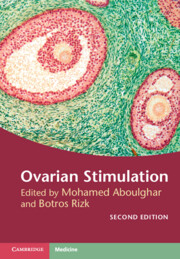Book contents
- Ovarian Stimulation
- Ovarian Stimulation
- Copyright page
- Dedication
- Contents
- Contributors
- About the Editors
- Foreword
- Preface to the first edition
- Preface to the second edition
- Section 1 Mild Forms of Ovarian Stimulation
- Section 2 Ovarian Hyperstimulation for IVF
- Section 3 Difficulties and Complications of Ovarian Stimulation and Implantation
- Chapter 12 Ovarian Stimulation in Difficult IVF Cases
- Chapter 13 Polycystic Ovary Syndrome: Ovulation Induction Strategies
- Chapter 14 Polycystic Ovary Syndrome: Controlled Ovarian Stimulation
- Chapter 15 Prevention of Ovarian Hyperstimulation Syndrome
- Chapter 16 Treatment of Ovarian Hyperstimulation Syndrome
- Chapter 17 How to Individualize Ovarian Stimulation Protocols to Avoid Difficulties and Complications
- Chapter 18 Endometrial Receptivity
- Chapter 19 Folliculogenesis and Implantation Failure
- Section 4 Non-conventional Forms Used during Ovarian Stimulation
- Section 5 Alternatives to Ovarian Hyperstimulation and Delayed Transfer
- Section 6 Procedures before, during, and after Ovarian Stimulation
- Index
- References
Chapter 18 - Endometrial Receptivity
from Section 3 - Difficulties and Complications of Ovarian Stimulation and Implantation
Published online by Cambridge University Press: 14 April 2022
- Ovarian Stimulation
- Ovarian Stimulation
- Copyright page
- Dedication
- Contents
- Contributors
- About the Editors
- Foreword
- Preface to the first edition
- Preface to the second edition
- Section 1 Mild Forms of Ovarian Stimulation
- Section 2 Ovarian Hyperstimulation for IVF
- Section 3 Difficulties and Complications of Ovarian Stimulation and Implantation
- Chapter 12 Ovarian Stimulation in Difficult IVF Cases
- Chapter 13 Polycystic Ovary Syndrome: Ovulation Induction Strategies
- Chapter 14 Polycystic Ovary Syndrome: Controlled Ovarian Stimulation
- Chapter 15 Prevention of Ovarian Hyperstimulation Syndrome
- Chapter 16 Treatment of Ovarian Hyperstimulation Syndrome
- Chapter 17 How to Individualize Ovarian Stimulation Protocols to Avoid Difficulties and Complications
- Chapter 18 Endometrial Receptivity
- Chapter 19 Folliculogenesis and Implantation Failure
- Section 4 Non-conventional Forms Used during Ovarian Stimulation
- Section 5 Alternatives to Ovarian Hyperstimulation and Delayed Transfer
- Section 6 Procedures before, during, and after Ovarian Stimulation
- Index
- References
Summary
Human reproduction is highly inefficient, and that is why it has been widely observed and documented since the ancient civilizations. Fertility has been a main concern along the history. Greeks already described “the best time for fruitful intercourse” [1] understanding that women are not fertile all days of the menstrual cycle. The poor effectiveness of the human species continuity is due to a fair number of factors involved to achieve a successful pregnancy: quality and quantity of sperm, ovum and embryo quality, chromosomal abnormalities, and the capability of the endometrium to harbor the embryo among others. The synchrony between the embryo development and the endometrium maturation must work as perfectly as the gear of a watch.
- Type
- Chapter
- Information
- Ovarian Stimulation , pp. 173 - 181Publisher: Cambridge University PressPrint publication year: 2022



